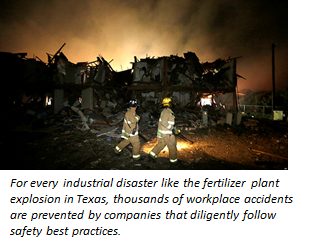Looking back at the news of 2013, it’s easy to have a bad feeling about workplace safety in 2014.
The explosive train derailment in Quebec, the fertilizer plant explosion in Texas, the factory fire in China, the gas explosion at the Pemex headquarters in Mexico City—these and many other deadly and costly industrial accidents made headlines last year.
 In almost every case, some key aspect of safety was neglected. In the China factory fire, for example, the culprit was a leaking liquid-ammonia tank. Regular equipment inspections, which are an essential element of safety, could have detected the leak.
In almost every case, some key aspect of safety was neglected. In the China factory fire, for example, the culprit was a leaking liquid-ammonia tank. Regular equipment inspections, which are an essential element of safety, could have detected the leak.
It’s discouraging to think that many enterprises—under pressure to reduce costs and increase productivity in the short-term—neglect basic safety steps. While being safe may take a little extra time and involve some minimal cost, safety ultimately pays off. Emphasizing safety not only protects people, it reduces costs and increases productivity in the long-term.
Being safe can become a sustainable competitive advantage—and every time I see another tragic headline about a workplace accident, I wish the companies involved had sufficiently appreciated this.
But 2013 wasn’t all bad safety news. Reports such as the following make me optimistic about safety in business for this year and beyond:
- The Journal of Occupational and Environmental Medicine published a study by HealthNEXT that focuses on the stock-market performance of companies that were awarded the annual Corporate Health Achievement Award from the American College of Occupational and Environmental Medicine. HealthNEXT’s researchers found that from the mid-1990s to 2012, the companies that won the award—which recognizes the safest companies in North America—had significantly better returns than the S&P 500. This serves as clear evidence of the correlation between “safety cultures” and business success.
- The U.S. Bureau of Labor Statistics released its workplace injury/illness incidence rates for 2012, and there was a decline in the leading indicator of the level of safety in business (the total non-fatal incidence rate for private industry). In 2012, there were 3.4 cases for every 100 equivalent full-time workers, down from 3.5 in 2011 and 2010. This continues a trend of yearly declines over the past decade (with the exception of 2011), and there’s no reason not to expect another decline when the 2013 numbers are released this year.
- The Commercial Vehicle Safety Alliance’s annual enforcement events—an unannounced Brake Check Day in May and Brake Safety Week in September—involved commercial vehicle inspectors from all over North America. The percentage of vehicles they had to take off the road because of bad brakes was the lowest in 15 years!
Those types of stories don’t grab headlines, but they do offer encouragement that occupational safety is gradually improving. I also know that for every tragedy that makes the news, there are thousands of potential tragedies that never occurred because of the growing number of companies insisting on safe operations.
My hope is that 2014 will see even more companies adopt that strategy. Lives will be saved, injuries will be averted, and bottom lines will improve.
Image courtesy of A Name Like Shields Can Make You Defensive, Creative Commons.










